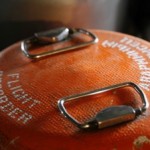Weekly Wrap Volume 100
 Why are People So Much Taller Today Than Historically?
Why are People So Much Taller Today Than Historically?
Over the last century and a half or so, humans, as a group, have grown significantly taller, with men from western, industrialized countries today being on average between 3 and 7 inches (7-18 cm) taller than their counterparts in the mid-19th century. So why have humans gotten taller? There is very strong evidence that this simply comes down to nutrition and the body’s ability to fully benefit from said nutrition via not getting certain diseases that hinder the absorption of consumed nutrients. That the environment is drastically more important than other factors, such as microevolution, is strongly indicated via looking at human height during times of relative comfort…(more)
 How the Phrase “Red Herring” Came to Mean Something That is Misleading
How the Phrase “Red Herring” Came to Mean Something That is Misleading
Meaning a distraction or false trail, the expression “red herring” has been relatively commonly used for the last two centuries, and its origins do, in fact, begin with a rust-colored fish. However, until quite recently, the accepted origins of red herring were themselves a false trail. The literal sense of a red herring dates to at least 1250 AD when Walter of Bibbesworth wrote in The Treatise, “He etep no ffyssh But Heryng red.” A product of the process used to preserve the fish into a kipper, the herring is cured in salt brine and then smoked for up to 10 days. If enough brine is used, the fish turns a red, coppery color with a rather strong smell. Capable of…(more)
Smelling salts have been used for everything, from reviving those who have fainted to athletes needing a chemically-induced “wake up.” But what are smelling salts? Are they actually an effective medical treatment? How do they work? Are they toxic and dangerous?Smelling salts aren’t what most people think of as “salt”; there isn’t sodium in smelling salts. The main and most active ingredient is ammonium carbonate ((NH4)2CO3H2O), a solid chemical compound that, when mixed with water (H2O), releases ammonia gas. Ammonium carbonate also goes by “baker’s ammonia,” due to the fact that it was used as a leavening agent prior to the popularity of baking soda or powder in the early to mid-19th century. In fact, baker’s ammonia is still…(more)
 Talking Tough: Martin Luther’s Potty Mouth
Talking Tough: Martin Luther’s Potty Mouth
On the last day of October in 1517, a scholar and priest named Martin Luther did as priests commonly did at the time when they had something to discuss amongst the clergy- he nailed a piece of paper to the door of the Castle Church in Wittenburg, Germany. Unlike many other such documents nailed to the doors of churches, this one sparked a religious and social revolution, and established Luther as a hero (to some) and father of the Protestant Reformation. Interestingly, some argue that to solidify his claim to leadership, Luther also felt he had to do something else – talk tough; and in 16th century Germany, that meant having a potty mouth. Regardless of his motivations, Luther could turn a filthy phrase with the best of them, as you’ll soon see…(more)
This Week’s YouTube Videos (Click to Subscribe!!)
- Why don’t Commercial Airplanes have Parachutes?
- Is It Really Possible To Tip a Cow?
- What is the “Sleep” in Your Eyes
- Does Cracking Your Knuckles Cause Arthritis?
- The Story of Dorothys Ruby Slippers
- Sushi is NOT Raw Fish
Bonus Quick Facts
- While watching news of the O.J. Simpson trial in the mid-1990s, retired advertising executive Dan FitzSimons realized that TV was missing something. During commercials, he often liked to flip around to find something else engaging until his main program came back on. His solution to the problem? The 24/7 Puppy Channel. He launched the channel in the late 1990s, with it on air until 2001. The content was exactly as you’d expect from the name “The Puppy Channel”- just footage of puppies playing and doing various puppy-like things.
- When Parcel Post Service first launched in America on January 1, 1913, there were few guidelines on what could be mailed. As a result, a handful of parents, spotting a bargain, began mailing their children. The first known case of this was the child of Mr. and Mrs. Jesse Beauge of Ohio only a few weeks after the launch of Parcel Post. They sent their son to his grandmother’s house for a fee of just 15 cents (about $3.72 today). On January 27, 1913, Mr. and Mrs. J.W. Savis of Pennsylvania mailed their daughter to relatives for a fee of 45 cents. More famously, 5 year old May Pierstorff of Idaho was mailed on February 19, 1914 73 miles to her grandmother’s house at a cost of just 53 cents (about $13.13 today). This was significantly cheaper than sending her on a passenger train, with the train ticket in question costing $1.55 according to the book, Mailing May. May’s case helped push forward an inquiry on the matter of mailing children and ultimately led to Postmaster General Albert Burleson declaring that, from that point forward, it was against the rules to mail human beings. Despite this, the practice continued for about two more years, finally stopping after an investigation into why three year old Maud Smith of Missouri was allowed to be mailed to her grandparents’ house in Kentucky. While you might have visions of children being put in boxes with holes in the side for air, this was not how the children were mailed. The appropriate number of stamps were simply affixed to their clothing along with the address they were to be sent. From there, they accompanied postal workers on the trains along with normal packages and then were escorted to their destinations.
- There is a so-called Double-Nosed Andean Tiger Hound “breed” of dog (not officially recognized as a breed) that, as the name suggests, has a split nose. It’s generally thought that these dogs probably descend from the Pachón Navarro breed, which has a much less pronounced split nose. These were brought to the Americas by Spanish explorers sometime in the 16th century.
- The Brothers Grimm didn’t just write fairy tales, they also worked for many years on a German dictionary that not only included the definitions of the words, but also the origin of each word. As you might expect, this was a monumental undertaking for just two people who lacked Google. They did not manage to finish their dictionary before dying, but did publish excerpts of the work, with the first installment published in 1852, 14 years after they’d started it.
- When the Pyramids of Giza were originally built, the outer part of the pyramids were made from smooth, highly polished Tura limestone, which was white, and meant to reflect the Sun. As for what happened to these white stones, many were taken and used in other projects, some of which still stand today such as a few mosques in Cairo; time and environmental conditions took care of most of the rest.
Other Interesting Stuff:
 Why the Toilet is Sometimes Called a “John”
Why the Toilet is Sometimes Called a “John”
The term is thought to derive from Sir John Harrington or, at the least, to have been popularized due to Harrington. (There are a few references of the toilet being called “Cousin John”, as well as many references to it being called “Jake” and other such generic names, before Harrington was born; but it is generally agreed that why we now call it “John” is because of Harrington and not from the old “Cousin John”). Sir John Harrington lived in the late 16th and early 17th centuries. Harrington was one of the 102 god-children of Queen Elizabeth I, known as the “Saucy Godson”, for his proclivity to write somewhat risqué poetry and other writings…(more)
 Are Airplane Black Boxes Really Black?
Are Airplane Black Boxes Really Black?
Like many inventions, versions of an airplane “black box” were independently invented by several people, in this case beginning around the 1930s and 1940s. As for the version that began being installed on commercial aircraft, it was invented in response to a tragic loss of life. A De Havilland Comet 1, the world’s first commercial jet-powered airplane, disintegrated over India in early 1953. Of the 43 passengers and crew members, none survived. Australian chemist Dr. David Warren joined an expert panel looking into the cause of that crash and two other crashes involving the Comet 1. Australia had a vested interest in the success of the Comet because of its possible use by Australian airlines for a route between Australia and the United Kingdom. While Dr. Warren was an expert in fuel research, the plane crashes resonated with him for another reason; his father died in 1934 when the plane he was on crashed into the ocean…(more)
 The Cause of Muscle Cramps When You Exercise
The Cause of Muscle Cramps When You Exercise
Cramps come in four categories: True cramps, Rest cramps, Tetanic cramps, and Dystonic cramps. The most common of these is the True cramp. While there are different causes of muscle cramps, like the involuntary contractions associated with seizures, we’ll focus on muscle cramping related to athletics, as this is the most common. Our bodies are composed of over 700 muscles that work together. Occasionally, involuntary contractions of one or more of these muscles will cause a cramp or spasm. A muscle cramp may involve a single muscle, part of a muscle or a number of muscles that work in synergy. Although most skeletal muscle cramps occur in foot and calf muscles, other muscles such as the thighs, arms, hands…(more)
 The Origin of Friday the 13th as an Unlucky Day
The Origin of Friday the 13th as an Unlucky Day
Being wary of Friday the 13th is much more than a quaint superstition observed by a few uneducated people in distant, unreachable towns and hamlets. In the United States alone, it is estimated that between 17 and 21 million people dread that date to the extent that it can be officially classified as a phobia. So why is Friday the 13th considered such an “evil” day? The origins aren’t perfectly clear, but we do know that both Friday and, separately, the number 13 have long been considered unlucky and it was around the late 19th…(more)
A popular notion of how they accomplished this used to be that the flies would do a half barrel roll sideways just before landing on the ceiling and then let their momentum carry them the rest of the way up. This was shown to be incorrect when, in 1958, Natural History Magazine took and published photos of flies landing on the ceiling. What is actually happening here is that as the fly approaches the ceiling, flying normally, it extends its forelegs above its head and grabs the ceiling with its front feet. It then uses its momentum to swing the rest of its body up until all its legs are firmly attached…(more)
| Share the Knowledge! |
|






